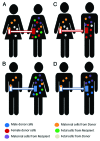Chimerism in women with end stage renal diseases: Who's who?
- PMID: 22854596
- PMCID: PMC3442814
- DOI: 10.4161/chim.21475
Chimerism in women with end stage renal diseases: Who's who?
Abstract
Many sources of foreign or semi foreign cells, known as microchimerism (Mc), can be found in healthy individuals. We have recently shown in women with end stage renal disease (ESRD) that Mc frequencies and levels are exacerbated prior to kidney transplantation. Is Mc arising from pregnancy a protective factor for renal diseases explaining lower incidence in women? Is Mc helpful in slowing down disease progression? However, natural Mc is not the only actor as post blood transfusion Mc is also found at high levels in women with ESRD. The difficulty is therefore to distinguish the different types of Mc and this is made even more complicated when the recipient receives a potentially chimeric organ. What part does each source of chimerism play in disease and transplant fate, and can one decipher each role knowing that one chimerism may hide another?
Figures

Comment on
- Albano L, Rak JM, Azzouz DF, Cassuto-Viguier E, Gugenheim J, Lambert NC. Male microchimerism at high levels in peripheral blood mononuclear cells from women with end stage renal disease before kidney transplantation. PLoS One. 2012;7:e32248. doi: 10.1371/journal.pone.0032248.
References
MeSH terms
Substances
LinkOut - more resources
Full Text Sources
Medical
